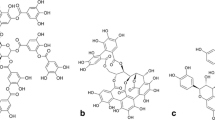Abstract
The biodegradation of wattle tannin was tested with six strains of yeasts isolated from decaying bark samples. The degradation of the condensed tannin was assayed in flasks and 2-liter jar fermentor by analysis of the residual leucoanthocyanin and flavanol groups after incubation during seven days. A strain of Candida guilliermondii (Y11) degraded rapidly flavanol groups without release of phenolic units in the fermentation broth using TLC analysis when a strain of Candida tropicalis Y65 mostly degraded the leucoanthocyanin groups with liberation of catechin. These results show for the first time the capacity of yeasts to degrade a condensed tannin suggesting an active role of these microorganisms in bark decomposition.
Resumé
La biodégradation du tanin de mimosa a été réalisée avec six souches de levures isolées d'échantillons d'écorces en décomposition. La dégradation de ce tanin condensé a été effectuée en fioles et en fermenteur de laboratoire de 2 litres en analysant les groupements leucoanthocyanine et flavanol après incubation pendant sept jours. Une des souches, Candida guilliermondii Y11 dégrade plus rapidement les groupements flavanols en ne libérant aucun composé phénolique simple visible en Chromatographie sur couche mince tandis qu'une autre souche (Candida tropicalis Y65) attaque plus rapidement les groupements leucoanthocyanine en libérant de la catéchine. Ces résultats montrent pour la première fois l'aptitude des levures à dégrader un tanin condensé et permet de leur attribuer un rôle actif dans la décomposition des écorces.
Similar content being viewed by others
Références
Aoki, K., Shinke, R. & Nishira, H., 1976. Purification and some properties of yeast tannase. Agr. Biol. Chem. 40: 79–85.
Blanchette, R. A. & Shaw, C. G., 1978. Associations among bacteria, yeasts and basidiomycetes during wood decay. Phytopathol. 68: 631–637.
Broadhurst, R. B. & Jones, W. T., 1978. Analysis of condensed tannins using acidified vanillin. J. Sci. Food Agric. 29: 788–794.
Deschamps, A. M., Mahoudeau, G. & Lebeault, J. M., 1980. Fast degradation of kraft-lignin by bacteria. Eur. J. Appl. Microbiol. Biotechnol. 9: 45–51.
Deschamps, A. M., Mahoudeau, G., Conti, M. & Lebeault, J. M., 1980. Bacteria degrading tannic acid and related compounds. J. Ferment. Technol. 58: 93–97.
Deschamps, A. M. & Lebeault, J. M., 1981. Bacterial degradation of tannins. In: Advances in Biotechnology (MooYoung, M. & Robinson, C. W., eds.), Vol. 3, pp. 639–644. Pergamon Press, New-York, London.
Deschamps, A. M., Gillie, J. P. & Lebeault, J. M., 1981. Direct delignification of untreated bark chips with mixed cultures of bacteria. Eur. J. Appl. Microbiol. Biotechnol. 13: 222–225.
Deschamps, A. M., 1982. Nutritional capacities of wood and bark decaying bacteria with particular emphasis on condensed tanins degrading strains. Eur. J. For. Pathol. 12: in press.
Ganya, P. S., Nandy, S. C. & Santappa, M., 1977. Effect of environmental factors on the production of fungal tannase. Leath. Sci. 24: 8–16.
Grant, W. D., 1976. Microbial degradation of condensed tannin. Science 193: 1137–1138.
Haslam, E., 1979. Vegetable tannins. In: Biochemistry of Plant Phenolics, pp. 475–524. Plenum-Press, New-York.
Iibuchi, S., Minoda, Y. & Yamada, K., 1972. Hydrolyzing pathway, substrate specificity and inhibition of tannin-acyl hydrolase of Aspergillus oryzae No. 7. Agr. Biol. Chem. 36: 1553–1562.
Jacob, F. H. & Vignal, M. C., 1975. Interactions levurestanins. II. Etude en milieu tannant de quelques levures hydrolysant l'acide tannique. Mycopathol. 57: 139–148.
Kirk, T. K., 1981. Principles of lignin degradation by whiterot fungi. Ejkman Days Proceedings 3: 66–70.
Lodder, 1971. The Yeasts: A Taxonomic Study. North-Holland Publishing Company, Amsterdam, New-York.
Roux, D. G. & Bill, M. C., 1959. Mechanism of formation of anthocyanidins form levco anthocyanidins. Nature 183: 42.
Sarkar, S. K. & Howarth, R. E., 1976. Specificity of the vanillin test for flavanols. J. Agric. Food. Chem. 24: 317–320.
Stahl, E. & Schorn, J., 1965. Hydrophilic constituants of plants. In: Thin-layer Chromatography, A Laboratory Handbook (Stahl, E., ed.), pp. 371–391. Springer-Verlag, Berlin-Heidelberg.
Updegraff, D. M. & Grant, W. D., 1975. Microbial utilization of Pinus radiata bark. Appl. Microbiol. 30: 722–726.
Yamada, K., Iibuchi, S. & Minoda, Y., 1967. Studies on tannin acyl-hydrolase of microorganisms. I. Isolation and identification of producing molds and studies on the conditions of cultivation. J. Ferment. Technol. 45: 233–240.
Author information
Authors and Affiliations
Rights and permissions
About this article
Cite this article
Ötük, G., Deschamps, A.M. Dégradation d'un tanin condensé par plusieurs types de levures. Mycopathologia 83, 107–111 (1983). https://doi.org/10.1007/BF00436891
Issue Date:
DOI: https://doi.org/10.1007/BF00436891



